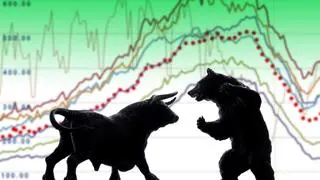Both the Indian as well the US central bankers disappointed the market last week.
While the RBI Governor decided to maintain status quo on policy rates, Ben Bernanke did not play to the gallery by assuring that the quantitative easing will continue for a very long time.
Stock markets were not unduly disappointed by the RBI’s stance and Indian stocks actually moved higher on Monday and Tuesday. It was the Federal Reserve that sent the rupee hurtling towards the 60 mark against the dollar that, in turn, caused widespread sell-off in the equity markets.
Foreign institutional investors pressed the sell button in both debt and equities. They have net sold shares worth $848 million so far in June. Their outflow from debt is $4.1 billion.
Stock prices could stay volatile next week as the June derivative contracts roll into expiry. Market will also keenly watch the movement of the rupee.
Any further fall in the currency can again cause a deluge of selling in the market. Volumes were high on Thursday and Friday as stocks turned volatile. Open interest on NSE derivative segment has also crossed Rs 1,50,000 crore ahead of the expiry. Oscillators in the daily chart continue to move deeper into the oversold zone implying that the short-term trend continues to be down.
Weekly oscillators are, however, still positive. They are hanging on in the neutral zone implying that the view has not turned negative along this time-frame yet.
Sensex (18,774.2)
The short-term trend in the Sensex is down since it closed near its intra-week trough. It is quite possible that the index continues to face downward pressure next week. In this event, the decline can continue to 18,385, 18,121 or 17,598.
In other words, investors can look forward to halt around the 18,000 level.
Any rally in the early part of the week can take the index to 19,313 or 19,745.
Inability to move above the first hurdle will mean that the index will decline in the days to come. Firm move above the second hurdle is required to signal a reversal in the short-term uptrend.
As we have been reiterating, the medium-term trend in the index continues to be up.
The third part of the correction that began this January appears to be unfolding now. It can halt around the 18,000 level and the uptrend can then resume.
Strong breach of 18,000 level will mean that a dip to 17,540 is possible. We will have to change our long-term view to negative only on decline below this mark.
Nifty (5,667.6)
The Nifty too closed on a weak note, down 141 points. If the decline continues early next week, the index can move to 5,618, 5,477 or 5,384 over the next couple of weeks.
A rally on Monday will face resistance at 5,850 and then 5,994. Inability to move above 5,850 will be the cue for investors to play short with stop-loss at 6,000.
Our medium-term view for the Nifty stays positive.
Decline to 5,500 or thereabouts followed by a recovery will mean that the index can move beyond 6,200 again in the ensuing months. Long-term view will be roiled only on a strong close below 5,350.
Global Cues
Most global benchmarks closed lower last week. The CBOE volatility index spiked higher to touch 21.2. This is the highest level recorded since January 2013 and a key short-term hurdle for the index.
Move above this level will mean that the short-term trend has turned adverse in US equities, since the CBOE VIX is based on the S&P 500 options.
Despite the 270 points fall, the Dow Jones Industrial Average is among the strongest global benchmarks currently. It ended the week above the short-term trend deciding level of 14,877. Next target for the index is at 14,444 and 14,356.
The medium-term view will turn negative only if the index goes on to record a strong weekly close below this level.
Most Asian benchmarks recorded sharp losses last week. Indices such as the Jakarta Composite Index and Thailand’s SET Index that were in a strong bull-run over the last couple of years even as other Asian indices were wilting, have also commenced serious medium-term corrections now.
The dollar index spiked sharply towards the end of last week as risk aversion soared.
It is once again drawing close to the resistance band between 83 and 85. Sharp move above 85 will mean that the index will move higher to the June 2010 peak at 89.








Comments
Comments have to be in English, and in full sentences. They cannot be abusive or personal. Please abide by our community guidelines for posting your comments.
We have migrated to a new commenting platform. If you are already a registered user of TheHindu Businessline and logged in, you may continue to engage with our articles. If you do not have an account please register and login to post comments. Users can access their older comments by logging into their accounts on Vuukle.